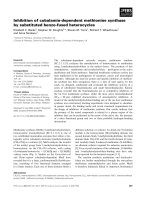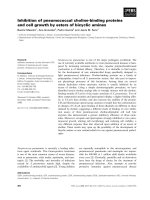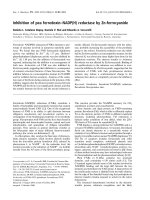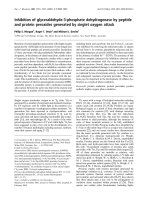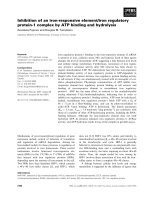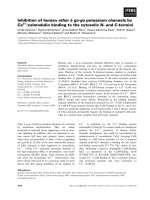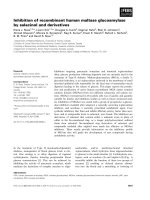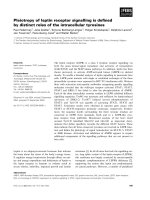Báo cáo khoa học: Inhibition of urokinase receptor gene expression and cell invasion by anti-uPAR DNAzymes in osteosarcoma cells pot
Bạn đang xem bản rút gọn của tài liệu. Xem và tải ngay bản đầy đủ của tài liệu tại đây (465.23 KB, 11 trang )
Inhibition of urokinase receptor gene expression and cell
invasion by anti-uPAR DNAzymes in osteosarcoma cells
Charles E. de Bock*, Zhen Lin*, Takashi Itoh, David Morris, George Murrell and Yao Wang
Orthopaedic Research Institute, Department of Medicine, St George Hospital, University of New South Wales, Sydney, NSW, Australia
The plasminogen activator system plays a central role
in wound healing, inflammatory and tissue dissolution,
and cell invasion and metastasis. Tumor cells need to
penetrate the extracellular matrix (ECM) and the base-
ment membrane in order to metastasize. The serine
protease family, which includes plasmin and urokin-
ase-type plasminogen activator (uPA), has been identi-
fied as being involved in the metastatic process. In a
clinical setting, members of the plasminogen activator
system, including the uPA receptor (uPAR), have been
found to be over-expressed in a large number of can-
cers leading to a poor prognosis [1,2]. This over-
expression of uPAR has resulted in its identification as
a potential target for anticancer drug development for
inhibiting metastasis [3,4].
uPAR is a cellular receptor for uPA, and is
anchored to the extracellular side of the cell membrane
via a glycosylphosphatidylinositol anchor. When uPA
binds to its receptor, it has the ability to direct proteo-
lytic activity toward the basement membrane and the
ECM by catalyzing plasminogen activation to form
plasmin. Plasmin then has the ability to either directly
degrade the basement membrane and ECM or activate
latent transforming growth factor-b, release basic
fibroblast growth factor from its ECM-binding sites,
and activate zymogens of matrix metalloproteinases,
Keywords
DNAzyme; gene expression; osteosarcoma
cell invasion; urokinase receptor
Correspondence
Y. Wang, Orthopaedic Research Institute, St
George Hospital, University of New South
Wales, Sydney, NSW 2217, Australia
Fax: +61 2 9350 3967
Tel: +61 2 9350 1422
E-mail:
*These authors contributed equally to this
work
(Received 11 October 2004, revised 28
February 2005, accepted 18 May 2005)
doi:10.1111/j.1742-4658.2005.04778.x
The urokinase-type plasminogen activator (uPA) receptor (uPAR) has been
implicated in signal transduction and biological processes including cancer
metastasis, angiogenesis, cell migration, and wound healing. It is a specific
cell surface receptor for its ligand uPA, which catalyzes the formation of
plasmin from plasminogen, thereby activating the proteolytic cascade that
contributes to the breakdown of extracellular matrix, a key step in cancer
metastasis. We have synthesized three different DNA enzymes (Dz372,
Dz483 and Dz720) targeting uPAR mRNA at three separate purine (A or
G)–pyrimidine (U or C) junctions. Two of these DNAzymes, Dz483 and
Dz720, cleaved uPAR transcript in vitro with high efficacy and specificity
at a molar ratio (uPAR to Dz) as low as 1 : 0.2. When analyzed over 2 h
with a 200-fold molar excess of DNAzymes to uPAR transcript, Dz720
and Dz483 were able to decrease uPAR transcript in vitro by 93% and
84%, respectively. They also showed an ability to cleave uPAR mRNA
in the human osteosarcoma cell line Saos-2 after transfection. The DNA-
zyme Dz720 decreased uPAR mRNA within 4 h of transfection, and inhi-
bited uPAR protein concentrations by 55% in Saos-2 cells. The decrease in
uPAR mRNA and protein concentrations caused by Dz720 significantly
suppressed Saos-2 cell invasion as assessed by an in vitro Matrigel assay.
The use of DNAzyme methodology adds a new potential clinical agent for
decreasing uPAR mRNA expression and inhibiting cancer invasion and
metastasis.
Abbreviations
ECM, extracellular matrix; DMEM, Dulbecco’s modified Eagle’s medium; PAI-1, plasminogen activator inhibitor-1; uPA, urokinase-type
plasminogen activator; uPAR, uPA receptor.
3572 FEBS Journal 272 (2005) 3572–3582 ª 2005 FEBS
all of which contribute to focal proteolysis and regu-
lation of wound healing, angiogenesis, and metastasis
[5].
Of the components of the uPA system, uPAR is of
particular interest as there is evidence that inhibition
of uPAR expression in cancer cells prevents the proces-
ses of invasion and metastasis. Our laboratory and
others have focused on an antisense approach, in par-
ticular aimed at decreasing the concentration of uPAR,
as a potential strategy for therapeutic intervention. In
early antisense strategies, a ribozyme approach with
a 37-mer hammerhead ribozyme was utilized and was
able to cleave uPAR mRNA in vitro to inhibit its
translation in a concentration-dependent manner [6].
Similarly, an antisense oligonucleotide (18-mer) that
covered the transcription start site of uPAR inhibited
the invasive properties of transformed human fibro-
blasts (VA-13) [7]. The down-regulation of uPAR in
the human glioblastoma cell line SNB19 by an anti-
sense construct of 300 bp to the 5¢ end of uPAR
mRNA led to a significant decrease in uPAR expres-
sion and also markedly decreased Matrigel invasion
[8]. When human squamous carcinoma Hep3 cells
were transfected with antisense uPAR, their ability to
metastasize in a chorioallantoic membrane assay
decreased [9]. We have previously cloned the human
uPAR gene and characterized its promoter and tran-
scription factors, including two AP-1 and one NF-jB
motifs [10–12]. We have also found that colon cancer
cell metastasis can be inhibited using antisense metho-
dology. In a nude mouse model, HCT116 colon cancer
cells with high invasive potential were transfected with
a plasmid containing uPAR cDNA ( 500 bp) in an
antisense orientation. Pulmonary metastases were
found in only 9% of mice injected with the clone intra-
venously, but were present in 67% of mice injected
with the parent HCT116 cells (P<0.05). These data
strongly support the importance of uPAR expression
in colon cancer invasion and metastasis [13].
To develop a potential tool for uPAR gene therapy,
we used a catalytic DNA enzyme (DNAzyme)
approach. The DNAzymes were originally generated
as ssDNA molecules composed of 31 deoxynucleotides,
including 15 for the core catalytic motif and eight for
each of the hybridizing arms [14]. These DNAzymes
have the ability to bind specific mRNA targets and
then catalyze a cleavage reaction in the presence of
bivalent cations. This specific cleavage reaction is
achieved by complementarity between the DNAzyme
and the sequences flanking the target mRNA. This
cleavage renders the mRNA incapable of undergoing
successful translation. The DNAzymes have high
enzymatic activity and cleave specific multiple target
mRNA sequences in the absence of any energy source
[15]. This report outlines the design of novel DNA-
zymes that target uPAR mRNA as a method of inhib-
iting its expression and thereby decreasing the invasive
potential of tumor cells.
Results
In vitro cleavage reaction and kinetic analysis
To study DNAzyme-mediated suppression of uPAR
expression, three DNAzymes carrying antisense uPAR
arms (Dz372, Dz483 and Dz720) and their correspond-
ing scrambled mutant controls were synthesized with
the same phosphorothioate substitutions for the last
three nucleotides at both ends (Table 1). The sites at
which the DNAzymes cut uPAR mRNA are illustrated
in Fig. 1. Dz372, Dz483 and Dz720 cut the uPAR
mRNA at nucleotides 372, 483 and 720, respectively,
according to the uPAR cDNA sequence published
[16]. The uPAR Dzs can cleave purine–pyrimidine
junctions. To select the target area, we scanned many
purine–pyrimidine junctions and their flanking regions
in the uPAR cDNA and compared their hybridization
properties according to the primer design rules. The
anti-uPAR Dzs contain 15 deoxynucleotides for the
core catalytic domain and nine for each of the hybrid-
izing arms. They have the ability to bind specific
uPAR mRNA by complementary base-pairing between
the Dz arms and the sequences flanking the uPAR
mRNA and then catalyse a cleavage reaction specific-
Table 1. Sequence of DNAzymes and site of cleavage of uPAR mRNA transcript. The catalytic core sequence is underlined. The correspond-
ing mutant control DNAzyme for each was made by scrambling the sequence of the left and right arms.
DNAzyme Sequence Cleavage site
Dz372 (active) 5¢-CTTCGGGAA
GGCTAGCTACAACGAAGGTGACAG-3¢
Dz372 (mutant) 5¢-TTCGGGAAC
GGCTAGCTACAACGAAGTGGACGA-3¢ 372 nt
Dz483 (active) 5¢-GTCACCACA
GGCTAGCTACAACGACCAGGCACT-3¢
Dz483 (mutant) 5¢-ACACCACTG
GGCTAGCTACAACGATCACGGACC-3¢ 483 nt
Dz720 (active) 5¢-GAGCATCCA
GGCTAGCTACAACGAGGGTGCTGT-3¢
Dz720 (mutant) 5¢-TAGAGCCAC
GGCTAGCTACAACGATTGGCGTGG-3¢ 720 nt
C. E. de Bock et al. Inhibition of uPAR by DNAzymes
FEBS Journal 272 (2005) 3572–3582 ª 2005 FEBS 3573
ally by Watson–Crick interactions. Using blast ana-
lysis, we determined that there is no DNA sequence
homology between our uPAR antisense (or Dz
mutant) hybridizing arms and any known mRNA
sequences.
In vitro cleavage reactions of a-
32
P-labeled uPAR
transcript were used to determine the kinetic and
sequence specificity of cleavage by the DNAzymes
and their controls. The amount of cleavage was
examined using a truncated a-
32
P-labeled 1113-nucleo-
tide uPAR transcript. The resulting two fragments
were resolved on a denaturing acrylamide gel. In vitro
cleavage results showed the expected two cleavage
products for all three DNAzymes. However, Dz372
had weak activity compared with Dz483 and Dz720
and was therefore omitted from further analysis (data
not shown).
To determine dose-dependent cleavage by the anti-
uPAR DNAzymes, experiments were carried out using
a range of molar ratios of substrate to DNAzyme con-
centrations (above and below a ratio of 1 : 1). As
shown in Fig. 2, over a 2 h incubation, uPAR transcript
was cleaved by Dz720 in a dose-dependent manner at
increased molar ratios (Fig. 2A, uPAR ⁄ Dz720 ¼
1 : 0.2, 0.5 or 1; Fig. 2C, uPAR ⁄ Dz720 ¼ 1 : 1, 10, 50,
100 or 200). A similar effect of Dz483 on uPAR tran-
script cleavage is shown in Fig. 2B,D. Initially Dz720
and Dz483 were evaluated at a molar ratio below 1 over
a 2 h period. For these low DNAzyme molarities,
Dz720 and Dz483 cleavage products were evident when
there was a fivefold excess of substrate to DNAzyme
(uPAR ⁄ Dz ¼ 1 : 0.2; Fig. 2A,B). At the higher molar
ratios above 1, with DNAzyme in excess of uPAR sub-
strate, Dz720 cleavage began with a 72% decrease at a
molar ratio of 1 : 1, and a maximum reduction of 93%
of uPAR substrate concentration at a molar ratio of
1 : 200 (Fig. 2C). A similar dose-dependent cleavage
was observed for Dz483, with cleavage at a 1 : 1 ratio
leading to a 65% decrease in uPAR substrate, and a
maximum reduction of 84% of uPAR substrate concen-
tration at a molar ratio of 1 : 200 (Fig. 2D). The speci-
ficity of the DNAzymes was confirmed by the lack of
cleavage by the untreated and mutant controls
(Fig. 2A–D), with no cleavage at 100-fold excess DNA-
zyme to uPAR substrate.
To determine the time-dependent reaction, experi-
ments were carried out with a 100-fold excess of DNA-
zyme to uPAR transcript substrate, and the cleavage
products analyzed over a 2 h period. For both Dz720
and Dz483, there was a rapid decrease of 50% of
uPAR transcript substrate within 10 min (Fig. 3).
After 2 h incubation, the final uPAR transcript con-
centrations were decreased 90% and 75% for
Dz720 and Dz483 cleavages, respectively (Fig. 3C,D).
To further confirm that the wild-type DNAzymes
and their mutants have no effect on other transcripts,
the DNAzymes were tested on labeled uPA and its
inhibitor PAI-1 mRNAs by in vitro transcription and
cleavage assays. To perform the assays, pGEM3Z vec-
tor containing a uPA cDNA fragment and pGEM3
vector carrying a PAI-1 cDNA fragment were restric-
tion digested. The linearized cDNAs were used as tem-
plates for in vitro RNA transcription using T7 or SP6
RNA polymerase. The RNA transcripts were labeled
Fig. 1. DNAzyme targeting sites in uPAR cDNA. Schematic representation showing the exon regions of uPAR cDNA and the regions tar-
geted by Dz372, Dz483 and Dz720. The hybridizing arm sequences are shown for each DNAzyme, and the catalytic core illustrated by a
loop. The full sequence for each respective DNAzyme is shown in Table 1.
Inhibition of uPAR by DNAzymes C. E. de Bock et al.
3574 FEBS Journal 272 (2005) 3572–3582 ª 2005 FEBS
with [
32
P]UTP[aP] and processed as described in
Experimental procedures. These experiments were car-
ried out with about a 200-fold excess of DNAzyme to
the transcript substrates and the cleavage products
analyzed. After 2 h incubation, the labeled uPAR
mRNAs were cleaved significantly by Dz720 or Dz483.
However, the labeled uPA and PAI-1 mRNA sub-
strates were not cleaved by a 200-fold excess of Dz720,
Dz483, and their mutants (data not shown).
Effect of DNAzymes on uPAR mRNA reduction
in Saos-2 cells
To investigate the effects of Dz720 and Dz483 on
uPAR mRNA changes, the DNAzymes were trans-
fected into Saos-2 cells. Previous studies by Zhang
et al. [17] investigating the stability of DNAzymes,
found detectable levels of DNAzymes within 2 h of
transfection. They were maintained in both cell cyto-
plasm and nucleus for the first 24 h before progres-
sively decreasing, and were still detectable after 48 h.
Our pilot dose-dependent analysis of DNAzyme con-
centration for cell transfection ranged from 1.6 to
10 lgÆ(mL cell medium)
)1
and showed optimum doses
in the range 1.6–3.2 lgÆmL
)1
for minimum cell toxic-
ity and maximum decrease in uPAR mRNA. We then
used this dose range to analyse uPAR mRNA
concentrations using northern blot analysis over a
24–48 h period.
After transfection of 1.6 lgÆmL
)1
either Dz720 or
Dz483 into the Saos-2 cells, total RNA was isolated
after various time points. As shown in Fig. 4, reduc-
tion of uPAR mRNA was noted within 4 h of trans-
fection for Dz720, leading to about 37% inhibition
of uPAR expression after 24 h compared with its
scrambled mutant control. However, with Dz483, the
first 24 h showed 24% decrease in uPAR mRNA
concentrations. The concentration of uPAR mRNA
was further decreased after 48 h, resulting in a 46%
reduction compared with its scrambled mutant con-
trol (Fig. 5B). To determine whether there was an
additive or synergistic effect by using a combination
of both active DNAzymes, northern blot analysis was
performed as above. We did not find any additive or
synergistic effect using both Dz720 and Dz483 simul-
taneously (data not shown).
Effect of DNAzymes on uPAR protein reduction
in Saos-2 cells
To determine whether this decrease in uPAR mRNA
was concomitant with a decrease in its protein,
uPAR protein was analysed using western blotting.
Single and double dose transfections did not result
in any significant decrease in uPAR protein, and
therefore a triple transfection protocol was under-
taken. The triple transfection protocol began with a
single dose using 3.2 lgÆmL
)1
Dz720, followed by
A
C
B
D
Fig. 2. Dose-dependent in vitro cleavage of
uPAR mRNA substrate by Dz720 and
Dz483. Different molar ratios of uPAR tran-
script to DNAzyme were incubated for
120 min at 37 °C. (A) Ratio of uPAR tran-
script ⁄ Dz720 from 1 : 0.2 to 1 : 1. (B) Ratio
of uPAR transcript ⁄ Dz483 from 1 : 0.2 to
1 : 1. (C) Ratio of uPAR transcript ⁄ Dz720
from 1 : 1 to 1 : 200. (D) Ratio of uPAR tran-
script ⁄ Dz483 from 1 : 1 to 1 : 200. The posi-
tions of the unreacted substrate (1113
nucleotides) and products are indicated.
Each experiment was repeated at least
three times.
C. E. de Bock et al. Inhibition of uPAR by DNAzymes
FEBS Journal 272 (2005) 3572–3582 ª 2005 FEBS 3575
two consecutive transfections of 1.6 lgÆmL
)1
each at
24 h intervals. The corresponding level of uPAR pro-
tein expression was also determined 24 h after the
third transfection. The Dz720 transfection resulted in
decreases of 72% and 57% in uPAR protein
after treatment with active DNAzyme compared with
untreated control and mutant control, respectively
(P<0.01). There was no significant difference in
the uPAR protein concentrations between the
untreated control and mutant DNAzyme-treated cells
(Fig. 5).
Inhibition of Saos-2 cell invasion by Dz720
The plasminogen activator system can promote the
breakdown of ECM and facilitate cell invasion and
metastasis. Increased expression of uPAR is associ-
ated with invasive cancer cell phenotypes and a poor
prognosis. The ability to decrease uPAR expression
levels would be advantageous to ameliorate this
effect. We therefore evaluated the capacity of Dz720
to inhibit cellular invasion of the Saos-2 cells through
basement membrane matrices using an in vitro Matri-
gel invasion assay. The cells were transfected three
times as described in western blot analysis, collected
24 h after the final transfection, and seeded into wells
containing Matrigel inserts and a filter pore size of
8 lm. After treatment with Dz720, there was a signi-
ficant decrease in cell invasion compared with
untreated and scrambled mutant controls (P<0.01)
(Fig. 6). Saos-2 cells treated with the active Dz720
had 42% and 17% fewer cells on the lower side of
the filter compared with untreated control cells
and cells treated with Dz720 mutant, respectively.
Although there was also a significant difference
between the untreated control and scrambled mutant
Dz720-treated cells, this may be caused by toxicity of
the DNAzyme molecules or the transfection reagent
Lipofectamine or their complex. This result suggests
that the targeting of uPAR by Dz720 can decrease
the potentially invasive phenotype of cells over-
expressing uPAR.
AB
CD
Fig. 3. In vitro cleavage of uPAR mRNA
substrate over time by Dz720 and Dz483.
The reactions were performed at 37 °Cat
a ratio of uPAR substrate to DNAzyme of
1 : 100. The cleavage reaction was analyzed
at different time points. The resulting frag-
ments were separated on denaturing 5%
acrylamide gel. (A) Dz720 cleavage of the
uPAR transcript over 120 min. The reaction
time and positions of the unreacted sub-
strate (1113 nucleotides) and products (720
nucleotides and 393 nucleotides) are indica-
ted. (B) Dz483 cleavage of the uPAR tran-
script over 120 min. The reaction time and
positions of the unreacted substrate (1113
nucleotides) and products (630 nucleotides
and 483 nucleotides) are indicated. (C) The
corresponding densitometry results of (A).
(D) The corresponding densitometry results
of (B). Each experiment was repeated at
least three times.
Inhibition of uPAR by DNAzymes C. E. de Bock et al.
3576 FEBS Journal 272 (2005) 3572–3582 ª 2005 FEBS
Discussion
In this paper we have shown that anti-uPAR DNA-
zymes were able to cleave uPAR mRNA in an in vitro
cleavage assay with high efficiency. When the DNA-
zymes were transfected into the osteosarcoma cell line,
Saos-2, it resulted in a significant loss of uPAR mRNA
expression and decreased concentrations of uPAR pro-
tein. This observed decrease in uPAR had the ability to
inhibit the invasive potential of human osteosarcoma
Saos-2 cells. This DNAzyme methodology offers an
alternative approach to decreasing uPAR concentra-
tions, which may be useful in a clinical setting. The ulti-
mate goal of the project is to develop an anti-uPAR
DNAzyme for anticancer therapy. This paper describes
the first step in the development of a potential thera-
peutic drug. It would be interesting to perform further
studies in other cancer cell lines and in an animal
model to show the efficacy of anti-uPAR DNAzymes
in preventing cancer cell growth and metastasis.
A number of approaches have been used to disrupt
the interaction between uPA and uPAR, in an attempt
to decrease cancer invasion and metastasis. These
methods include the use of antibodies, small molecule
antagonists, and antisense strategies and have been
reviewed elsewhere [3]. Although antisense oligonucleo-
tides are one of the most well established methods for
suppressing gene expression, they have a number of
limitations; a useful review can be found elsewhere
[18]. The DNAzyme technique offers a new way of
suppressing gene expression. In comparison with other
antisense technologies, including antisense oligonucleo-
tides, ribozymes, and RNAi, the strength of the DNA-
zyme approach lies in its inexpensive production,
excellent catalytic activity, and the ability to modify its
backbone for systemic delivery in the absence of a vec-
tor [19]. We have therefore designed DNAzymes that
target uPAR mRNA. Using an in vitro cleavage assay,
we found dose-dependent cleavage of uPAR mRNA at
molar ratios (uPAR ⁄ Dz) from 1 : 1 to 1 : 200 resulting
in 65% to 93% decreases, respectively, in uPAR tran-
script substrate. As shown in Fig. 2, DNAzymes
Dz720 and Dz483 can cleave their target uPAR tran-
script at a molar ratio as low as 1 : 0.2.
AC
BD
Fig. 4. Effect of Dz720 and Dz483 on uPAR mRNA concentrations in cultured Saos-2 cells. (A) The cells were transfected with Dz720
(1.6 lgÆmL
)1
) for 4, 8, 12 and 24 h. 20 lg total RNA was used for northern blot, and the blot was hybridized with [
32
P]dCTP[aP]-labeled
uPAR cDNA and 18S rDNA probes as a control. Autoradiographic exposure time was 24 h (for uPAR as probe) and 2 h (for 18S rDNA as
probe). (B) The corresponding densitometry results are shown. After normalization for loading with 18S rRNA, the decrease in uPAR is calcu-
lated as the fraction compared with the mutant DNAzyme control. (C) The cells were transfected with Dz483 (1.6 lgÆmL
)1
) for 24, 48 and
72 h. Total RNA (20 lg) was used for northern blot analysis and processed as described above. Autoradiographic exposure time was 24 h
(for uPAR as probe) and 2 h (for 18S rDNA as probe). (D) The corresponding densitometry results are shown after normalization for loading
with 18S rRNA. The decrease in uPAR was calculated as the fraction compared with the mutant DNAzyme control. Each experiment was
repeated at least three times and a representative data set is shown in the figure.
C. E. de Bock et al. Inhibition of uPAR by DNAzymes
FEBS Journal 272 (2005) 3572–3582 ª 2005 FEBS 3577
We then assessed the ability of Dz720 and Dz483 to
suppress uPAR mRNA expression in the Saos-2 cells.
A reduction of 37% was seen within 24 h for Dz720,
but a slower decrease was evident with Dz483, with
only 24% reduction seen 24 h after the initial trans-
fection. The significant kinetic differences and ability
to cleave uPAR mRNA between Dz720 and Dz483
may be related to decreased accessibility to the partic-
ular region being targeted. This has been hypothesized
to be due to tertiary RNA structures inhibiting access
to some sites. It has been postulated that up to 90%
of putative targets on long RNAs are resistant to clea-
vage by DNAzymes, with different constraints on the
ability of DNAzymes to hybridize (in comparison with
antisense oligonucleotides) because of the bulky nature
of the activity centre acting as a barrier to accessible
sites [20,21]. One method used to increase the efficacy
of DNAzymes is to introduce 2¢-O-methyl RNA or
locked nucleic acid monomers into the binding arms of
the DNAzyme. This can result in cleavage of sites that
were previously unsuitable [20].
As shown in Fig. 5, a triple transfection procedure
was used to detect changes in uPAR protein. Nor-
thern blot analysis showed that the concentration of
uPAR mRNA was 51% less than that of the cor-
responding mutant control after the third Dz720
transfection for 24 h using the same transfection
method as in Fig. 4 (data not shown). This result
shows that two more transfections further decreased
uPAR mRNA as compared with data in Fig. 4. The
requirement for the triple transfection for uPAR pro-
tein reduction may be due to differences in half-life
between uPAR protein and mRNA. The plasminogen
system is complicated because of the presence of
uPAR not only on the cell surface, but also in an
internalized compartment after binding of uPA and
its inhibitor PAI-1. Western blot was used to analyze
total uPAR protein of both intracellular and extra-
cellular compartments. The triple transfection used to
observe a decrease in uPAR protein is speculated to
be a combination of both DNAzyme half-life and the
multicompartmental state of uPAR, such that the
concentration of uPAR mRNA must be maintained
at low concentrations to ensure that all compartments
are depleted of uPAR protein. The long half-life of
the uPAR protein may be due to the discrepancy
between a single and triple transfection approach. A
future useful experiment would be to treat cells with
cycloheximide to inhibit translation, and then treat
them with Dz720 to determine whether uPAR protein
decreases at a faster rate as the result of existing
uPAR mRNA cleavage.
Regardless of the efficiency of cleavage, one of the
major challenges facing the future application of
DNAzymes in a clinical setting is cellular uptake and
its half-life within a cell for long-term gene suppres-
sion. One attempt to increase the half-life has been
made by designing and constructing a novel endogen-
ously replicating circular DNAzyme. This was devel-
oped by cloning a specific DNAzyme into the vector
M13mp18. The circular DNAzyme was able to cleave
b-lactamase mRNA both in vitro and in bacteria.
However, it should be noted that, although the half-
life may have increased, the overall efficacy of the cir-
cular DNAzyme was less than its linear counterpart.
This was postulated to be due to the super-coiled
nature of a proportion of the plasmid, trapping the
active center [22]. To overcome the obstacle of tumor-
specific delivery in vivo, the use of transferrin-modified,
cyclodextrin polymer-based polycations has resulted in
the intracellular delivery of DNAzymes after intraven-
ous administration to mice. The system showed longer
tumor retention and efficient cell targeting compared
with unformulated and targeted DNAzymes [23].
This study has shown that the anti-uPAR DNA-
zyme Dz720 can inhibit cancer cell invasion. The
A
B
Fig. 5. Expression of uPAR protein concentrations in Saos-2 cells
after Dz720 treatment. The cells were transfected three times
at 24 h intervals with 3.2 lgÆmL
)1
, 1.6 lgÆmL
)1
, and 1.6 lgÆmL
)1
,
respectively. They were then lysed 24 h after the third transfection.
(A) Representative levels of uPAR protein expression are shown.
Each sample (untreated control, Dz720 mutant and Dz720 active)
was electrophoresed in duplicate. (B) The corresponding densito-
metry of three replicate experiments is shown. Columns, means of
three separate experiments normalized to b-actin expression and as
a fraction of untreated control. Statistical evaluation showed that
the effect of Dz720 in reduction of uPAR protein concentrations in
the Saos-2 cells was significant as shown by ***P < 0.01.
Inhibition of uPAR by DNAzymes C. E. de Bock et al.
3578 FEBS Journal 272 (2005) 3572–3582 ª 2005 FEBS
reduction in in vitro invasion of the Saos-2 cells was
modest. This could be for a variety of reasons. For
example, in vitro invasion is a complex process, and
redundant proteolytic systems might compensate for
the repression of uPAR expression. It may be specula-
ted that the observed decrease can be attributed to
uPAR, with other compensatory mechanisms allowing
the cell invasion process to continue.
uPA binding to uPAR has been shown to induce the
proliferation of Saos-2 cells, therefore down-regulation
of uPAR expression in these cells may have antiproli-
ferative effects. To test whether the decreased number
of cells on the Matrigel filters in the Dz720-treated
wells is due to an anti-invasive effect rather than an
antiproliferative effect, a cell proliferation assay was
carried out. Only an 8% decrease in cell proliferation
was found in Dz720 mutant controls compared with
active Dz720 (data not shown), whereas our cell inva-
sion assay (Fig. 6) showed a 17% difference between
active Dz720 and Dz720 mutant controls. Therefore,
the inhibition of invasion seen in this study is due
mainly to a decrease in invasion and partly to a
decrease in cell proliferation. These results are consis-
tent with the known roles of uPAR in both cell proli-
feration and cell invasion.
Previously we found that an antisense uPAR frag-
ment stably integrated into the colon cancer cell line
HCT116 led to the suppression of the Erk-MAP kinase
pathway and reductions in uPA secretion, cell adhe-
sion, and plasminogen-dependent matrix degradation.
Importantly, the uPAR–b1 integrin complex was also
disrupted in the antisense cell clone, with this inter-
action important in maintaining the invasive pheno-
type of colon cancer cells [24]. It may be speculated
that the decreased uPAR expression caused by Dz720
leads to a decrease in activation of downstream mole-
cules involved in the uPAR signaling pathway such as
the Erk-MAP kinase pathway. It will be interesting to
investigate further the exact nature of the inhibition of
cell invasion by the anti-uPAR DNAzyme Dz720.
Recently, down-regulation of the uPA–uPAR inter-
action was attained by the delivery of antisense
sequences to both uPA and uPAR in a single adeno-
viral vector. The bicistronic construct had the ability
to significantly reduce the concentrations of uPA and
uPAR in a glioma cell line and thereby diminish inva-
siveness and tumorigenicity [25]. This research shows
A
B
C
D
Fig. 6. Invasion of Saos-2 cells measured in Matrigel-coated tran-
swell chambers. Invading cells were stained with 1% toluidine blue
and visualized by microscopy. (A) Untreated cells. (B) Cells trans-
fected with Dz720 mutant. (C) Cells transfected with Dz720 active.
(D) Graphical representation of toluidine blue-stained cells after
invasion, calculated by
AREA PERCENT software (Carl Zeiss). Each
experiment was repeated at least three times. Columns, means of
three separate experiments as a fraction of untreated control. Sta-
tistical evaluation showed that the effect of Dz720 in inhibition of
Saos-2 cell invasion was significant as shown by ***P<0.01.
C. E. de Bock et al. Inhibition of uPAR by DNAzymes
FEBS Journal 272 (2005) 3572–3582 ª 2005 FEBS 3579
that the simultaneous targeting of two components in
a single system can have a synergistic effect rather than
only an additive effect. Our study provides opportunit-
ies for a similar approach using DNAzymes that target
both uPA and uPAR to further inhibit cancer cell
invasion and metastasis.
Experimental procedures
Materials
The DNAzymes were synthesized by Geneworks Pty Ltd
(Hindmarsh, SA, Australia). The TRIzol reagent was pur-
chased from Invitrogen Corporation (Carlsbad, CA, USA).
Murine IgG anti-human uPAR (No. 3931) monoclonal
antibody was purchased from American Diagnostica Inc
(Greenwich, CT, USA). The enhanced chemiluminescence
was purchased from Pierce (Rockford, IL, USA).
In vitro translation and cleavage assay
The 1.4-kb cDNA fragment of uPAR contained in pBlue-
script was restriction-digested, separated on a 1% agarose
gel, and purified. The product was then subcloned into
the pGEM vector of the Riboprobe Combination system
(Promega, Madison, WI, USA) and used as a template
for in vitro RNA transcription using T7 RNA polymerase.
The RNA transcript was labeled with [
32
P]UTP[aP] for
90 min. DNA template was digested by DNase I, and the
RNA purified. The RNA pellet was collected by centrifu-
gation and dissolved in diethyl pyrocarbonate-treated
dH
2
O. The quantified transcript was subjected to cleavage
by DNAzymes in cleavage buffer (50 mm Tris ⁄ HCl,
pH 7.5, 10 mm MgCl
2
). Cleavage products were separated
on a denaturing (1 · Tris ⁄ borate ⁄ EDTA buffer ⁄ 7 m
urea ⁄ 5% acrylamide) gel. The gel was then exposed to
Kodak Biomax MR film.
Cell culture and transfection
The human osteosarcoma cell line Saos-2 was obtained
from the American Type Culture Collection (Manassas,
VA, USA) and maintained in Dulbecco’s modified Eagle’s
medium (DMEM; Invitrogen) supplemented with 10%
fetal bovine serum (Hyclone, Tauranga, New Zealand)
and 1% antibiotics at 37 °C and 5% CO
2
. Before cell har-
vesting, cell viability was consistently found to be > 90%.
For transfections, the Saos-2 cells were plated in 100-mm
culture dishes containing DMEM with 10% fetal bovine
serum without antibiotics and then treated with Lipofecta-
mine 2000 (Invitrogen) with or without active DNAzyme
or scrambled mutant in the presence of opti-MEM I
reduced serum medium (Invitrogen). After 4 h of serum
starvation in the presence of the DNAzyme–Lipofectamine
complex, the medium was replaced with DMEM contain-
ing 10% fetal bovine serum. Cells were collected and
assayed by northern and western blot analyses at variable
time points after transfections. For multiple transfections,
the same method was used with 24 h intervals between
successive transfections.
Northern blot analysis
Total RNA was isolated from Saos-2 cells with TRIzol
Reagents using standard protocols of Invitrogen. Aliquots
of 20 lg total RNA were size separated on a 1.2% agarose
gel containing 2.2 m formaldehyde and 1· Mops buffer.
The RNA was transferred to a nitrocellulose membrane
and immobilized by baking at 80 °C for 2 h and UV cross-
linking 30 000 lJÆcm
)2
(UVC 508 ultraviolet cross linker;
Ultra-Lum Inc, Claremont, CA, USA). The cDNA probes
for uPAR and 18S rRNA were radiolabeled with
[
32
P]dCTP[aP] using the Prime-a-Gene Labeling system
(Promega) and purified using ProbeQuant G-50 micro
columns (Amersham Biosciences, Piscataway, NJ, USA).
The membranes were then processed in hybridization buffer
[5· NaCl ⁄ Cit, 5· Denhardt’s, 50% formamide, 50 mm
sodium phosphate buffer (pH 6.7), 0.1% (w ⁄ v) SDS,
100 lgÆmL
)1
heat-denatured herring sperm DNA] contain-
ing labeled probe at 1 · 10
6
c.p.m.ÆmL
)1
at 42 °C for
48–72 h. After hybridization, the membranes were washed
and exposed to Kodak Biomax MR film. Multiple film
exposures were used to ensure linearity of band intensities.
The intensities of mRNA bands in the autoradiographs
were scanned and quantified by an Imaging Densitometer
(model GS-700 ⁄ 690; Bio-Rad, Hercules, CA, USA). Intensi-
ties of uPAR mRNA were calculated relative to the inten-
sity of the 18S rRNA internal control.
Western blot analysis
Cells were washed with NaCl ⁄ P
i
, trypsinized, and collected.
For protein extraction, the cells were lysed in 1· cell lysis
buffer (20 mm Tris ⁄ HCl (pH 7.5), 150 mm NaCl, 1 mm
EDTA, 1 mm EGTA, 1% Triton X-100, 2.5 mm sodium
pyrophosphate, 1 mm b-glycerophosphate, 1 mm sodium
orthovanadate, 1 lgÆmL
)1
leupeptin, 10 lgÆmL
)1
aprotinin,
1mm phenylmethanesulfonyl fluoride, 1 lgÆmL
)1
pepstatin
A, 100 lgÆmL
)1
aminoethylbenzenesulfonyl fluoride). Sup-
ernatants containing equal amounts of protein (40 lg) in
sample buffer [62.5 mm Tris ⁄ HCl (pH 6.8), 2% SDS, 10%
glycerol, 50 mm dithiothreitol] were separated on a
SDS ⁄ 12% (v ⁄ v) polyacrylamide gel. Fractionated proteins
were then transferred to poly(vinylidene difluoride) mem-
brane that was then probed with uPAR antibody (No.
3931). Immunoreactive bands were visualized by Super-
signal West Pico Chemiluminescence (Pierce) and quantified
by densitometry (model GS-700 ⁄ 690; Bio-Rad). To ensure
Inhibition of uPAR by DNAzymes C. E. de Bock et al.
3580 FEBS Journal 272 (2005) 3572–3582 ª 2005 FEBS
equal protein loading, b-actin was used as an internal
control.
Cell invasion assay
The migratory and invasive responses of Saos-2 cells were
determined using the BD Biocoat Matrigel Invasion Cham-
ber (24-well, 8 lm pore size) according to the manufacturer’s
instructions (Becton and Dickinson, Franklin Lakes, NJ,
USA). Briefly, Saos-2 cells were transfected three times with
Dz720 at 24 h intervals and then collected 24 h after the final
transfection. Approximately 5 · 10
5
cells were seeded into
the 24-well chambers in DMEM containing 1% fetal bovine
serum. The mixture 10% fetal bovine serum ⁄ 0.5 mgÆmL
)1
collagen I (Sigma) was used as a chemoattractant. After
24 h, the Matrigel inserts were removed, and the noninvad-
ing cells removed from the upper surface of the membrane
by gentle scrubbing using a cotton tipped swab. The cells on
the lower surface were fixed and stained with 100% meth-
anol and 1% toluidine blue, respectively. The membranes
were then mounted and analyzed by microscopy. Four fields
per filter were used to quantify cell invasion using area per-
cent 1.0 software (Carl Zeiss, Thornwood, NY, USA).
Data analysis
All values are expressed as the mean ± SD. Statistical sig-
nificance was calculated using Student’s t-test where
appropriate.
Acknowledgements
We thank Dr Lunquan Sun for technical advice, and A.
Q. Wei for her help. This work was supported by Foun-
dation for Research Science and Technology, New
Zealand; St George Hospital ⁄ South-eastern Sydney
Area Health Service, St George Private Hospital ⁄ Health
Care of Australia, the Australian Kidney Foundation
(S1002) and Arthritis Foundation of Australia.
References
1 Schmitt M, Harbeck N, Thomssen C, Wilhelm O,
Magdolen V, Reuning U, Ulm K, Hofler H, Janicke F
& Graeff H (1997) Clinical impact of the plasminogen
activation system in tumor invasion and metastasis:
prognostic relevance and target for therapy. Thromb
Haemost 78, 285–296.
2 de Bock CE & Wang Y (2004) Clinical significance of
urokinase-type plasminogen activator receptor (uPAR)
expression in cancer. Med Res Rev 24, 13–39.
3 Mazar AP (2001) The urokinase plasminogen activator
receptor (uPAR) as a target for the diagnosis and ther-
apy of cancer. Anti-Cancer Drugs 12, 387–400.
4 Sidenius N & Blasi F (2003) The urokinase plasminogen
activator system in cancer: recent advances and implica-
tion for prognosis and therapy. Cancer Metastasis Rev
22, 205–222.
5 Andreasen PA, Egelund R & Petersen HH (2000) The
plasminogen activation system in tumor growth, inva-
sion, and metastasis. Cell Mol Life Sci 57, 25–40.
6 Kariko K, Megyeri K, Xiao Q & Barnathan ES (1994)
Lipofectin-aided cell delivery of ribozyme targeted to
human urokinase receptor mRNA. FEBS Lett 352,
41–44.
7 Quattrone A, Fibbi G, Anichini E, Pucci M, Zamperini
A, Capaccioli S & Del Rosso M (1995) Reversion of the
invasive phenotype of transformed human fibroblasts by
anti-messenger oligonucleotide inhibition of urokinase
receptor gene expression. Cancer Res 55, 90–95.
8 Mohanam S, Chintala SK, Go Y, Bhattacharya A,
Venkaiah B, Boyd D, Gokaslan ZL, Sawaya R & Rao
JS (1997) In vitro inhibition of human glioblastoma cell
line invasiveness by antisense uPA receptor. Oncogene
14, 1351–1359.
9 Kook YH, Adamski J, Zelent A & Ossowski L (1994)
The effect of antisense inhibition of urokinase receptor
in human squamous cell carcinoma on malignancy.
EMBO J 13, 3983–3991.
10 Wang Y, Dang J, Johnson LK, Selhamer JJ & Doe WF
(1995) Structure of the human urokinase receptor gene
and its similarity to CD59 and the Ly-6 family. Eur J
Biochem 227, 116–122.
11 Dang J, Boyd D, Wang H, Allgayer H, Doe WF &
Wang Y (1999) A region between )141 and )61 bp con-
taining a proximal AP-1 is essential for constitutive
expression of urokinase-type plasminogen activator
receptor. Eur J Biochem 264, 92–99.
12 Wang Y, Dang J, Wang H, Allgayer H, Murrell GA &
Boyd D (2000) Identification of a novel nuclear factor-
kappaB sequence involved in expression of urokinase-
type plasminogen activator receptor. Eur J Biochem
267, 3248–3254.
13 Wang Y, Liang XM, Wu SS, Murrell GAC & Doe WF
(2001) Inhibition of colon cancer metastasis by a 3¢-end
antisense urokinase receptor mRNA in a nude mouse
model. Int J Cancer 92, 257–262.
14 Santoro SW & Joyce GF (1997) A general purpose
RNA-cleaving DNA enzyme. Proc Natl Acad Sci USA
94, 4262–4266.
15 Cairns MJ, Saravolac EG & Sun LQ (2002) Catalytic
DNA: a novel tool for gene suppression. Curr Drug
Targets 3, 269–279.
16 Roldan AL, Cubellis MV, Masucci MT, Behrendt N,
Lund LR, Dano K, Appella E & Blasi F (1990) Cloning
and expression of the receptor for human urokinase
plasminogen activator, a central molecule in cell surface,
plasmin dependent proteolysis. EMBO J 9, 467–474.
C. E. de Bock et al. Inhibition of uPAR by DNAzymes
FEBS Journal 272 (2005) 3572–3582 ª 2005 FEBS 3581
17 Zhang X, Xu Y, Ling H & Hattori T (1999) Inhibition
of infection of incoming HIV-1 virus by RNA-cleaving
DNA enzyme. FEBS Lett 458, 151–156.
18 Stein CA (2001) The experimental use of antisense
oligonucleotides: a guide for the perplexed. J Clin Invest
108, 641–644.
19 Scherer LJ & Rossi JJ (2003) Approaches for the
sequence-specific knockdown of mRNA. Nat Biotechnol
21, 1457–1465.
20 Schubert S, Furste JP, Werk D, Grunert HP, Zeich-
hardt H, Erdmann VA & Kurreck J (2004) Gaining
target access for deoxyribozymes. J Mol Biol 339,
355–363.
21 Cairns MJ, Hopkins TM, Witherington C, Wang L &
Sun LQ (1999) Target site selection for an RNA-cleav-
ing catalytic DNA. Nat Biotechnol 17, 480–486.
22 Chen F, Wang R, Li Z, Liu B, Wang X, Sun Y, Hao D
& Zhang J (2004) A novel replicating circular DNA-
zyme. Nucleic Acids Res 32, 2336–2341.
23 Pun SH, Bellocq NC, Cheng J, Grubbs BH, Jensen GS,
Davis ME, Tack F, Brewster M, Janicot M, Janssens B,
et al. (2004) Targeted delivery of RNA-Cleaving DNA
enzyme (DNAzyme) to tumor tissue by transferrin-
modified, cyclodextrin-based particles. Cancer Biol Ther
3, 641–650.
24 Ahmed N, Oliva K, Wang Y, Quinn M & Rice G
(2003) Downregulation of urokinase plasminogen acti-
vator receptor expression inhibits Erk signalling with
concomitant suppression of invasiveness due to loss of
uPAR-beta1 integrin complex in colon cancer cells. Br J
Cancer 89, 374–384.
25 Gondi CS, Lakka SS, Yanamandra N, Siddique K,
Dinh DH, Olivero WC, Gujrati M & Rao JS (2003)
Expression of antisense uPAR and antisense uPA from
a bicistronic adenoviral construct inhibits glioma cell
invasion, tumor growth, and angiogenesis. Oncogene 22,
5967–5975.
Inhibition of uPAR by DNAzymes C. E. de Bock et al.
3582 FEBS Journal 272 (2005) 3572–3582 ª 2005 FEBS
